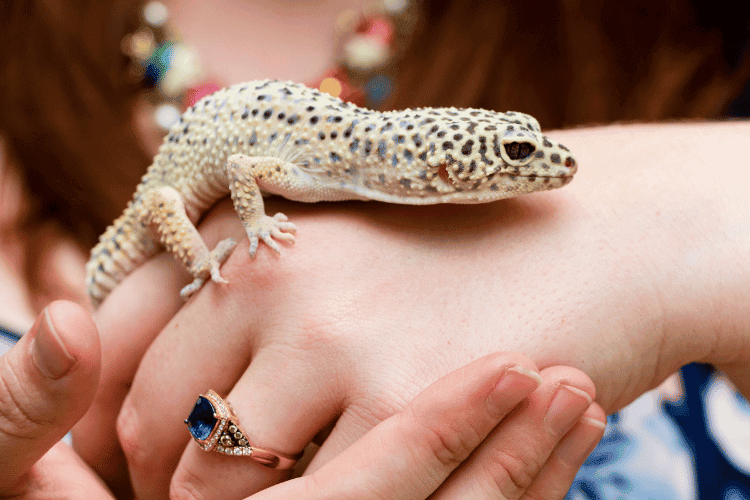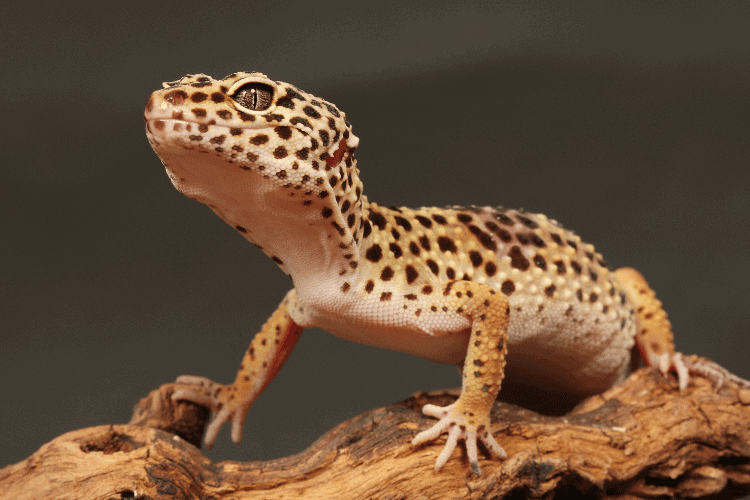Hey there, fellow leopard gecko enthusiasts!
If you’ve clicked on this article, you’ve probably noticed something intriguing about your gecko’s behavior; those rapid throat movements.
Today, we’ll explore the different reasons behind those fast throat movements, which range from natural behaviors that showcase their unique personalities to potential red flags that could signal underlying health issues.
Leopard geckos are fascinating creatures with their own quirks and personalities. Let’s jump right into it.
Is Rapid Throat Movement in Leopard Geckos Normal?
If your leopard gecko’s throat is moving fast, you have nothing to worry about. Leopard geckos, like many reptiles, can display various behaviors that might seem unusual to us but are actually normal behavior for their species.
One of these behaviors involves the rapid movement of their throat, which can be attributed to communication, social signaling, courtship, energy conservation, and more.
Reasons Your Leopard Gecko’s Throat Is Moving Fast
Here are the potential reasons why your leopard gecko’s throat moves fast:
1. Communication and Social Signaling
Communication is fundamental to survival in the animal kingdom, and leopard geckos are adept communicators. They’re actually quite the minglers!
Through throat pulsing, leopard geckos can communicate their presence, territorial boundaries, and even reproductive readiness to other geckos.
Males, in particular, exhibit vigorous throat pulsing during the mating season to attract potential mates and establish dominance over rivals.
This pulsing serves as a visual and vibrational signal that aids in reducing direct confrontations and minimizing the risk of injury.
2. Temperature Regulation
Leopard geckos are ectothermic creatures, which means their body temperature is regulated by external sources, primarily through behaviors like basking.
Rapid throat movement can also contribute to temperature regulation!
By dilating and constricting blood vessels near the skin’s surface, leopard geckos can effectively alter blood flow and heat exchange.
This behavior helps them regulate their body temperature by either getting ride of excess heat or conserving warmth.
A leopard gecko’s throat region is particularly thin-skinned and rich in blood vessels, making it an efficient site for thermal regulation.
3. Swallowing Process
When a leopard gecko’s throat pulsates rapidly it is often a sign of swallowing.
These movements facilitate the passage of food down the esophagus by helping push the food bolus through the digestive system.
The rhythmic contractions of the throat muscles assist in moving the prey item or food particles efficiently toward the stomach for digestion.
Related: What Do Leopard Geckos Eat?
4. Stress and Agitation
In captivity, leopard geckos may exhibit fast throat movement as a response to stress or agitation. Factors such as handling, sudden changes in environment, or the presence of predators (real or perceived) can trigger this behavior.
The rapid throbbing of the throat is a clear indication of the leopard gecko’s discomfort, urging the handler to provide a more suitable and secure environment.
By closely observing the throat pulsing, leopard gecko owners can gauge the well-being of the gecko and take action when necessary.
5. Prey Detection and Hunting Strategy
Leopard geckos are nocturnal predators with a unique hunting strategy. Their superb eyesight, coupled with keen senses of smell and touch, helps them find prey.
Rapid throat movement could be a part of their hunting strategy, aiding in prey detection.
While research is ongoing, it’s thought that throat pulsing might create subtle vibrations in the surrounding environment.
The vibrations could mimic the movement of insects and draw the gecko’s attention to potential prey, giving them a slight advantage in their nighttime hunts.
6. Response to Environmental Stimuli
Leopard geckos are highly sensitive to changes in their environment. Their rapid throat movement can be a response to various stimuli, such as sudden noises, vibrations, or unfamiliar scents.
This behavior may serve as a form of vigilance or alertness, helping the gecko prepare for any potential threats.
By staying attuned to their surroundings, leopard geckos enhance their chances of survival in their natural habitats.

7. Breathing and Respiratory Function
Although not the primary function, rapid throat movement could play a role in aiding the gecko’s breathing and respiratory processes.
By expanding and contracting their throat region, these reptiles could help air movement and gas exchange within their respiratory system.
This behavior might become more obvious during periods of increased physical activity or when the gecko is exposed to challenging environmental conditions.
8. Courtship and Reproduction
One of the most captivating aspects of leopard gecko behavior is their courtship rituals. During the mating season, the male performs intricate displays to attract the female leopard gecko.
Rapid throat movement is a central element of these courtship rituals!
The male geckos rhythmically pulse their throats while approaching females, creating a visually striking and audibly distinct display.
This behavior in leopard geckos not only shows the male’s vitality and health but also communicates his readiness to mate.
The vibrant throbbing is believed to be an attractive signal that helps the female gecko choose suitable partners for reproduction.
9. Energy Conservation
Leopard geckos are skilled at conserving energy when necessary. The rapid movement of the throat might serve an energy-saving function.
Instead of engaging in physically demanding displays or behaviors, leopard geckos can use throat pulsing to communicate without expending excessive energy.
This behavior might be particularly useful during periods of resource scarcity or when geckos are in energy-saving mode, such as during colder seasons.
10. Social Hierarchy and Dominance
Within a population of leopard geckos, a social hierarchy often exists. Rapid throat movement plays a role in establishing and maintaining this hierarchy.
Dominant individuals tend to exhibit more frequent and intense throat pulsing, asserting their status within the group.
Subordinate geckos, on the other hand, might display less vigorous throat movement to avoid confrontations with dominant individuals.
This behavior-based hierarchy helps minimize conflicts and maintains a sense of order within the group.
What Should You Do When You Notice Fast Throat Movement?
Most of the reasons associated with fast throat movement in a leopard gecko aren’t a cause of concern. However, in some cases, your pet’s throat might be moving fast due to stress.
If you suspect that this is the case, here are a few things to consider:
- Observe: Keep a close eye on your leopard gecko to see if there are any other signs of distress or unusual behavior. Monitor its overall behavior, appetite, and activity level.
- Check the Environment: Make sure your gecko’s enclosure is set up correctly. Tank temperature, humidity level, lighting setup, and hiding spots should all be appropriate for the species. Incorrect environmental conditions can lead to stress.
- Handling: If you’ve recently handled the gecko, it might be stressed from the interaction. Leopard geckos are generally more comfortable with minimal handling, so make sure not to overdo it.
- Feeding: If your gecko is in the process of swallowing or digesting food, you might observe throat movements. However, if these movements persist after feeding, if your pet is showing a lack of appetite, it could be a sign of a digestive problem.
- Respiratory Issues: Rapid throat movement could also indicate respiratory issues. Observe if your gecko is having difficulty breathing, making wheezing sounds, or if there’s any mucus around the nostrils or mouth.
When to See a Vet
If you’re concerned about your gecko’s health or if the rapid throat movements continue for an extended period, it’s advisable to consult a veterinarian experienced in reptile care. They can provide a proper diagnosis and recommend appropriate treatment if necessary.
Remember that leopard geckos are delicate creatures, and any sudden change in behavior should be taken seriously. It’s better to be cautious and seek professional help when in doubt.
Regular health checkups and proper husbandry practices can prevent many potential health issues. So, don’t neglect them.

FAQs
Why does my gecko move its neck?
It’s normal for a leopard gecko to move its neck and throat area while breathing. The amount of movement will vary with the activity level.
When the gecko is very active, it will require more oxygen and the movement in their neck will increase.
Further, herpetologists suggest that the behavior—described as buccal pulsing—helps lizards smell a larger quantity of air.
Essentially, it is the gecko’s version of sniffing!
How do I know if there’s a respiratory infection?
Detecting a respiratory infection in your gecko requires careful observation of its behavior and physical condition.
Here are some signs to watch out for:
- Abnormal breathing
- Mucus or discharge
- Lethargy
- Loss of appetite
- Coughing or clicking sounds
- Unusual posture
- Visible swelling or discoloration
If you observe any combination of these symptoms, it’s important to consult a veterinarian who has experience with reptiles, particularly leopard geckos.
Why do lizards expand their throat?
Lizards expand their throat to display dominance, attract mates, and communicate. The inflated throat, known as the “dewlap”, shows off the lizard’s vibrant colors and patterns. This helps lizards establish social hierarchy and engage in reproductive behaviors.
Wrapping Up
While rapid throat movements can be normal, it’s also important to be observant of your gecko’s overall health and behavior.
If you notice any other unusual behaviors, changes in appetite, weight loss, lethargy, or signs of distress, it’s a good idea to consult with a veterinarian experienced in reptile care.
They can provide a more accurate assessment of your pet gecko’s health and offer guidance if there is a potential issue.


